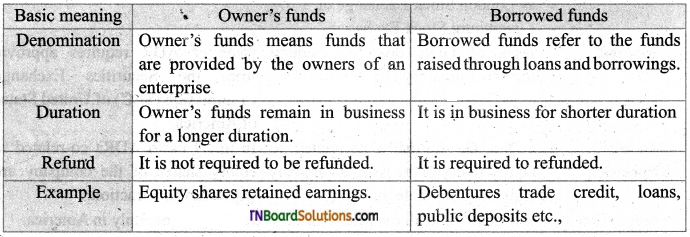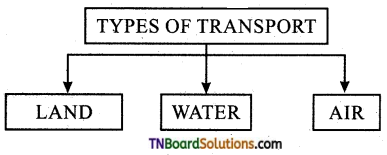Students get through the TN Board 11th Commerce Important Questions Chapter 21 Micro, Small and Medium Enterprises (MSME) and Self Help Groups (SHGs) which is useful for their exam preparation.
TN State Board 11th Commerce Important Questions Chapter 21 Micro, Small and Medium Enterprises (MSME) and Self Help Groups (SHGs)
Very short answer questions
Question 1.
Give full form of SIDBI.
Answer:
Small Industries Development Bank of India.
Question 2.
Give full form of NABARD.
Answer:
National Bank for Agriculture and Rural Development
Question 3.
Discuss any two characteristics of SSI.
Answer:
- They are run as sole proprietorships or partnerships.
- Normally they use labor-intensive methods.
![]()
Question 4.
Name any two units included in the SSI category.
Answer:
Export-oriented units and Ancillary units.
Question 5.
What are different parameters used to measure the size of a business?
Answer:
Following parameters may be used to measure the size of the business:
- A number of workers employed.
- Size of plant and machinery.
- Total output.
- Inventory size.
Question 6.
What are small sector industries in the village?
Answer:
The small sector industries in the village are:
- Handlooms,
- Handicrafts,
- Coir,
- Sericulture,
- Khadi industries,
- Village industries,
- Small scale industries and power loom.
Question 7.
Give example Commercial Bank.
Answer:
Commercial Banks: Public sector banks.
eg: State Bank of India, Indian Bank, Indian Overseas Bank, Canara Bank.
Private sector banks: e§: ICICI, Axis Bank, City Union Bank, HDFC, Karur Vasya Bank, Tamilnadu Mercantile Bank.
![]()
Question 8.
Give an example for non-banking finance institutions?
Answer:
Non-Banking Finance Institutions:
- National Small Industries Corporation Ltd (NSIC).
- Small Industries Development Bank of India (SIDBI).
Question 9.
Examples of the regional rural banks.
Answer:
- Pandian Rural Bank.
- Pallavan Rural Bank.
- Vallalar Rural Bank.
Question 10.
Examples of cooperative banks.
Answer:
- TNSC Bank.
- District Central Co-operative Bank.
Question 11.
Example of micro-finance Institutions.
Answer:
Mudra Bank.
Short answer questions
Question 1.
State the objective of small bu Iness in rural India.
Answer:
- To create more employment opportunities with less investment
- The removal of the more economic backwardness of rural and less developed regions of the economy.
- They reduce regional imbalances.
- The mobilization and ensure optimum utilization of unexploited resources of the country.
![]()
Question 2.
What is the role of district industries center for the growth of small businesses in India?
Answer:
The district industries centers programme was launched on May 1st 1978, with a view to providing an integrated administrative framework at the district level which looks at the problem of industrialization in the district.
Question 3.
Write a short note on Mudra Bank.
Answer:
The Government of India has launched MUDRA Bank with a capital amount of Rs. 20,000 Crores and a credit guarantee corpus of Rs. 3,000 Crores, to help micro small, and medium enterprises and startups to resolve problems relating to financing.
Question 4.
Explain (MSME Sector).
Answer:
MSME Sector provides more employment opportunities to the people of India. It helps towards the industrialization of rural and backward areas. This sector reduces regional imbalances. It provides an equitable distribution of national income and wealth.
Question 5.
Explain Micro Enterprises.
Answer:
Micro Enterprises are engaged in low scale activities such as:
- Clay pot making.
- Fruits and vegetable vendors.
- Transport (three-wheeler, tempos, and autos).
- Repair shops.
- Cottage industries, small industries.
- Handlooms, handicraft works, etc.
![]()
Long answer questions
Question 1.
What are the modes of linkage to self-help groups?
Answer:
There are three distinct modes of credit to SHGs. Under the first mode, banks lend directly to the SHGs. In the second mode, banks provide loans to the NGOs for onward lending to the SHGs and ultimately to micro-entrepreneurs. Under the third mode, banks extend credit to the SHGs with the NGOs serving as facilitators. Out of these three methods, the last method of direct lending by the bank with NGO facilitation is widely practiced.
Question 2.
Write short notes on self, help groups in India.
Answer:
In December 2017 there were 45,67,090 SHGs in India. The total number of members in SHGs during the same period stood at 5,02,65,933 at all Indian levels. The five-year plans of the government of India have given due recognition to the relevance of the Self-help group concept to implement developmental schemes at the grassroots level.
Question 3.
Write a short note on SHG’s in Tamil Nadu.
Answer:
In Tamil Nadu, Tamil Nadu Corporation for Development of Women Limited (TNCDW) was established in the year1983 with the prime objective of socio-economic development and empowerment of rural women. The Government of Tamil Nadu spearheaded the Self Help Group concept in the country by forming SHGs in Dharmapuri district with the assistance of the International Fund for Agricultural Development (IFAD) in September 1989. The success of the IFAD project paved way for the now popularly called “Mahalir Thittam” project, which was launched during 1997-98 with the State Government funding and was progressively extended to all the 30 districts. The SHG movement has now emerged as a powerful and vibrant movement illuminating the lives of many poor women in the state.
![]()
For Own Thinking
1. Role of women as entrepreneurs.
Answer:
One of the famous Indian women entrepreneurs is Indira Nooyi. She was born in Chennai and had her bachelor’s degree in Madras Christian College. Master’s Degree in public management from Yale University. Masters in Finance and Marketing from IIM, Kolkata.
Occupation: Joined PepsiCo in 1994 and became CFO in 2001. Earlier she held Senior Executive positions in Motorola and Asia Brown Boveri.
She was a product manager at Johnson and Johnson and then textile firm mettur Beardsell. Awarded PadmaBushan for her business achievements and for being an inspiration to India’s corporate leadership.
She helped the company to complete 30 billion dollars worth of crucial deals within the last couple of years.
2. Income-tax exemption for Start-up initiatives.
Answer:
The Government of India has launched Mudra Bank with a capital amount of Rs. 20,000 Crore and credit guarantee corpus of Rs. 3000 Crore to help MSMEs and startups to resolve problems relating to income tax exemption and financing.
![]()
For Future learning
1. World Association of Small & Medium enterprises (WASME).
Answer:
UNICTAD, ITC, WIPO, UNESCO, UNESCAP, global nonprofit organization head quarters – Noida (India).
2. Ministry of MSME and its functions.
Answer:
Ministry of MSME. Its function is to honor the people who are producing quality goods. Gandhimathi appliances are honored by the Ministry of MSME. National Award 2010. Quality product in Micro and «* small enterprises for LPG operated stoves/appliance.
Multiple choice questions
1. Village and Small industries together provide the ………. employment opportunities in India.
(a) largest
(b) smallest
(c) highest
(d) self
Answer:
(a) largest
2. How much do small industries in India account for the total industrial units?
(a) 100%
(b) 95%
(c) 80%
(d) 75%
Answer:
(b) 95%
![]()
3. What is the investment limit for SSI?
(a) One crore
(b) Two crore
(c) Three crore
(d) Five crore
Answer:
(a) One crore
4. Name the apex bank set up to provide direct and indirect financial assistance to the small-scale sector?
(a) UTI
(b) SBI
(c) SIDBI
(d) RBI
Answer:
(c) SIDBI
5. Name any two units included in:
(a) UTI
(b) NABARD
(c) SIDBI
(d) SSI
Answer:
(d) SSI
6. Name any two institutions specially set up to promote small scale enterprise:
(a) SIDBI & SIDCO
(b) NABARD
(c) WASME
(d) KVIC
Answer:
(a) SIDBI & SIDCO
![]()
7. Public sector banks example:
(a) Pandian Rural bank
(b) ICICI
(c) State Bank of India
(d) Mudra bank
Answer:
(c) State Bank of India
8. Regional Rural bank example:
(a) Indian bank
(b) Pallavan Rural Bank
(c) HDFC
(d) KVB
Answer:
(b) Pallavan Rural Bank
9. Co-operative Banks example:
(a) TNSC
(b) NSIC
(c) SIDBI
(d) SBI
Answer:
(a) TNSC
![]()
10. Tamilnadu Mercantile Bank example:
(a) public sector
(b) private sector
(c) regional rural bank
(d) co-operative bank
Answer:
(b) private sector



